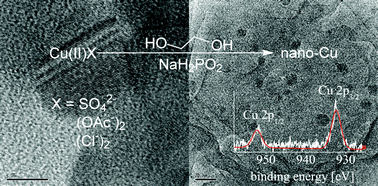Nanoparticulate copper – routes towards oxidative stability
Abstract
A modified polyol-based

* Corresponding authors
a
The University Chemical Laboratories, Lensfield Road, Cambridge CB2 1EW, UK
E-mail:
aehw2@cam.ac.uk
Fax: +44 1223 336362
Tel: +44 1223 763122
b Laboratory of Chemical Reactor Engineering, Eindhoven University of Technology, P. O. Box 513, Eindhoven, The Netherlands
A modified polyol-based

 Please wait while we load your content...
Something went wrong. Try again?
Please wait while we load your content...
Something went wrong. Try again?
V. Engels, F. Benaskar, D. A. Jefferson, B. F. G. Johnson and A. E. H. Wheatley, Dalton Trans., 2010, 39, 6496 DOI: 10.1039/C0DT00134A
To request permission to reproduce material from this article, please go to the Copyright Clearance Center request page.
If you are an author contributing to an RSC publication, you do not need to request permission provided correct acknowledgement is given.
If you are the author of this article, you do not need to request permission to reproduce figures and diagrams provided correct acknowledgement is given. If you want to reproduce the whole article in a third-party publication (excluding your thesis/dissertation for which permission is not required) please go to the Copyright Clearance Center request page.
Read more about how to correctly acknowledge RSC content.
 Fetching data from CrossRef.
Fetching data from CrossRef.
This may take some time to load.
Loading related content
